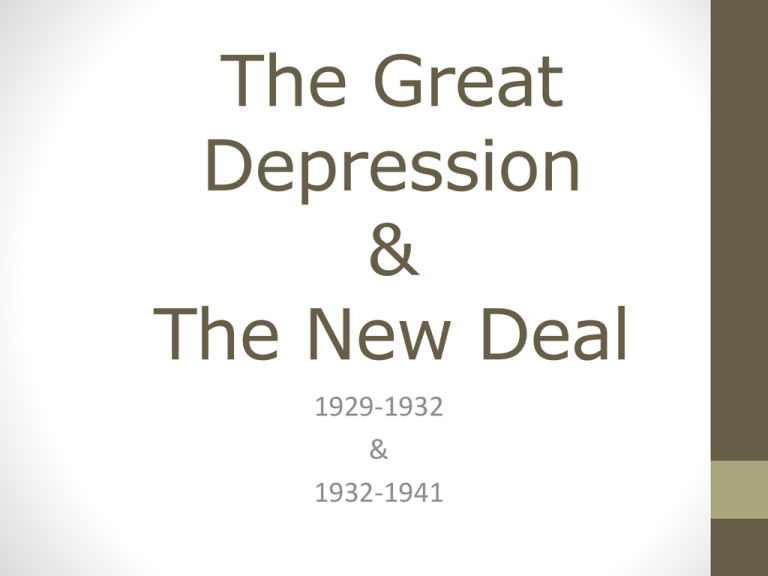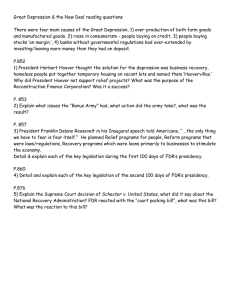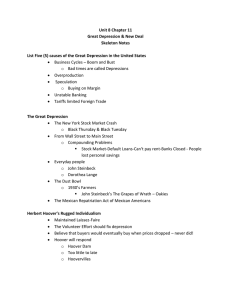The Great Depression & The New Deal
advertisement

The Great Depression & The New Deal 1929-1932 & 1932-1941 In the 1928 presidential race, the Republican Party was confident. Republicans took credit for the strong economy of the 20s. Their presidential candidate, Herbert Hoover, believed in voluntary cooperation between business and labor. Despite Hoovers confidence, some saw signs of weakness in the economy. The agricultural sector was in trouble. Rural farmers produced huge surpluses of food that depressed prices. Farmers could not afford to buy goods or repay their loans. Credit and installment buying lead people to purchase goods they can’t pay for. By 1929, Americans had more than $6 billion debt >double the 1921 level. Rising wages masked an uneven distribution of wealth. Factory workers’ wages rose 8%, factory output increased by 32%. As a result, worker incomes rose modestly, while rich investor incomes skyrocketed. 3 Disasters of The Great Depression • The Stock Market Crash • Black Tuesday - October 29, 1929 • Run on Banks • After the Market Crash • Causes Bank Failures • Overproduction/Under-consumption • Economic issue throughout the 20s • Most problematic in agriculture sector The Market Crash - Black Tuesday Until September 1929, the stock market continued to rise. Many people borrowed money to buy stock, assuming prices would continue to go up. Some economists feared that stocks were over-priced. October 29th, the stock market went into a free fall as investors tried to sell at any price. 16 million shares were sold on “Black Tuesday.” Billions of dollars were lost in a few hours. Many who bought stocks on margin were wiped out. Run on Banks The crash didn’t start the Great Depression by itself. Instead, it quickened the collapse of the U.S. economy. Run on Banks Banking system felt effects of crash first. People feared losing money so they ran to the bank to withdraw funds. But banks didn’t have enough cash on hand. Bank runs caused banks to fail. Overproduction/Underconsumption • Overproduction - Producing more goods than can be sold • Throughout the 1920s production agricultural goods remained high despite lower demand after war • Mainly due to the mechanization of farming • Under-consumption - Buying fewer goods than are produced • Created a rural depression - farmers did not feel the roar of the 1920s Farmers no longer had cash to buy consumer goods Factories closed, causing worker layoffs, increased unemployment Lowered demand for goods. By 1933, the unemployment rate in the U.S. reached 25%. As international trade falls, a global drop in business leads to a worldwide depression. Few Americans understood the causes of the Great Depression, but everyone felt the impact. For many, the only food available came from public soup kitchens or bread lines run by charitable organizations. People sold their possessions and homes to buy food. Between 1921–1929, the unemployment rate never rose above 4%. By 1933, however, it was near 25%. Those who kept their jobs had their wages and hours cut. Hoovervilles Between 1930 and 1934, nearly a million farmers lost their farms, homes, and farm equipment because they could not pay their mortgages. Bankers sold the land and equipment at auction. Some farmers became tenant farmers, working for bigger landowners. Others decided to leave in search of work elsewhere in the U.S. Hoovervilles (shantytowns set up on empty land named after the President) appeared in major cities across the country. The homeless lived in empty railroad cars, in cardboard boxes, or in shacks built on public land or empty lots. The Dust Bowl Millions of tons of topsoil blown away in giant dust storms. A drought on the Great Plains destroyed millions of acres of farmland. Farmers removed thick prairie grasses to plant wheat which did not grow in the drought. 100 mile-per-hour winds blew dust clouds 8,000 feet tall in Oklahoma, Texas, New Mexico, and Colorado. Wildlife and farm animals suffocated in the choking winds. Westward Migration Farmers who had lost their land, called Okies regardless of where they were from, were forced to leave. Displaced farmers moved west or to northern cities. 800,000 Okies left Texas, Oklahoma, Missouri, and Arkansas alone. Those who could bought distressed neighbors’ farms at low prices to build expanded commercial farms. Americans looked to President Herbert Hoover to solve the crisis. He tried a number of different approaches, but in the end he failed to discover the right formula for stopping the crisis. At the start of the economic downturn, Hoover took a hands-off approach. Believed that shifts in the economy were a natural part of the business cycle. Thought strong businesses would succeed without government support. Hoover realized he must do something: Asked businesses to keep wages, employment, and prices at current levels Called for tax cuts, lower interest rates, and public works Asked wealthy to donate more money to charity But volunteerism failed: Hoover put his faith in localism, a policy whereby problems are best solved at the local and state levels. Towns and states didn’t have resources to deal with the depression. Did not support direct federal aid to individuals. Minor Success One success was the construction of Boulder Dam (later renamed Hoover Dam). Put thousands to work, provided power for millions, and irrigation for acres farm land. Many grew disillusioned during the Great Depression. • Some blamed Hoover and some blamed capitalism. • Some were World War I veterans who wanted a bonus that was promised to them. • In 1932, those veterans formed the Bonus Army and marched on Washington. 20,000 veterans set up camps and occupied vacant buildings. In July, police tried to evict them and riots erupted. Hoover ordered General Douglas MacArthur to remove veterans. He used tear gas, cavalry, tanks, and troops. Photos of troops using excessive force angered the American public. The eviction of the Bonus Army doomed Hoover’s bid for re-election. Americans were ready for new leadership and a greater role for the government in solving problems. Hoover’s opponent in the election was Democrat Franklin D. Roosevelt. • Harvard graduate • New York State senator • Assistant Secretary of the Navy • 1920 Nominee for Vice President • Polio survivor • Governor of New York Hoover State & local governments and private agencies should provide relief. The two candidates offered very different approaches to the problems of the Great Depression. Roosevelt Leadership should come from the federal government. Roosevelt won in a landslide. Roosevelt’s Response to The Great Depression THE NEW DEAL First 100 Days Roosevelt moved quickly to carry out his promise of giving Americans a New Deal. During his first 100 days in office, 15 bills were passed. Three goals: Reform, Relief, and Recovery. Reform – Fix the banking system Relief – Provide jobs and resources for farmers and unemployed Americans Recovery – Rebuild the American economy FDR took other steps to reform the financial system. Federal Deposit Insurance Corporation (FDIC) Insured bank deposits Securities and Exchange Commission (SEC) Regulated the stock market Such measures helped restore confidence in the economy. Roosevelt then turned to a series of New Deal programs to bring relief to the country. Some programs helped farmers and those in the rural South. • The AAA sought to end overproduction and raise crop prices. • The TVA built dams to control floods and generate electricity. Many programs focused on job relief Civilian Conservation Corps (CCC) Put young men to work improving national parks, forests, and wilderness areas Federal Emergency Relief Agency (FERA) Granted funds to state and local agencies to helped the unemployed Civil Works Administration (CWA) Gave people jobs on public-works projects The Public Works Administration (PWA) created millions of jobs. • Workers built bridges, dams, power plants, and government buildings. • These projects improved the nation’s Roosevelt also took steps to infrastructure. speed economic recovery. National Recovery Administration (NRA) • Established codes of fair competition • Set minimum wages for workers and minimum prices for goods In 1935, FDR launched a new campaign to help meet the goals of relief, recovery, and reform called the Second New Deal Economists such as John Maynard Keynes disagreed. Critics charged that New Deal programs, and their high price tags, were wasteful. • The government was spending money it did not have. • The federal deficit had soared to $4.4 billion. • Public-works projects put money in the hands of consumers. • Consumer spending would stimulate the economy. • Deficit spending was needed to end the depression. The Social Security Act created a pension system for retirees. It also provided: • unemployment insurance • insurance for work-related accidents • aid for poverty-stricken mothers and children, the blind, and the disabled Such benefits helped reduce poverty among the nation’s elderly. The government also funded irrigation systems, dams, and other water projects in the West. Construction of a Dam, a mural by WPA artist William Gropper, was a tribute to workers on western dams. Roosevelt believed that improving the standard of living for industrial workers would benefit the entire economy. Wagner Act • Recognized the right of workers to join labor unions Fair Labor Standards Act • Gave workers the right to collective bargaining Setbacks and limitations After the economy had begun to improve in 1935 and 1936, FDR cut back on government spending to reduce the deficit. At the same time, interest rates rose. The combination caused the economy to sink again, and unemployment soared. With his support wavering, FDR did not try to push further reforms through Congress. Eleanor Roosevelt inspired many women in her leadership role during the New Deal. • Transformed the role of First Lady from ceremonial to political activist • Traveled widely • Campaigned for FDR • Offered policy advice • Wrote a newspaper column Other women also played important roles in the administration, such as Secretary of Labor Frances Perkins, the first female Cabinet member. •The WPA and other However, the New agencies made an effort Deal did not fight to employ men first. to end gender discrimination in •Women could not work the workplace. for the CCC. The New Deal’s Commissioner of Indian Affairs, John Collier, tried to improve living conditions for Native Americans. The Bureau of Indian Affairs encouraged native religions, languages, and customs. The Indian New Deal: • Provided funds to build schools and hospitals • Created an Indian Civilian Conservation Corps The Indian Reorganization Act of 1934 was considered the centerpiece of the Indian New Deal. This law restored tribal control over native lands. With the New Deal, FDR broke from the tradition of laissez-faire and greatly expanded the role of government. New Deal measures strengthened capitalism and encouraged the post-WWII economic boom. • Restored trust in the banks and the stock market • Increased homeownership • Protected workers • Helped modernize rural America At the same time, the New Deal led to the rise of the welfare state. In a major policy change, the New Deal established the principle that the federal government was responsible for the welfare of all Americans. FDR also favored federal action to protect the environment. The government established 12 million acres of new national parks. The CCC restored forests and preserved the environment. Finally, FDR and the New Deal changed the nature of the presidency itself. Cultural Changes of the 30s How did the men and women of the depression find relief from their hardships in the popular culture? Entertainment helped Americans struggling to survive the depression escape their worries—at least for a time. Federal support for the arts added to the era’s rich cultural heritage. During the New Deal, the federal government provided funding for the arts for the first time in history. The Federal Art Project, Federal Writers’ Project, and Federal Theater Project were all funded by the WPA. • WPA writers created a series of state guidebooks that recorded the nation’s history and folklore. • Artists painted giant murals in public buildings across the nation. • Photographers like Dorothea Lange created powerful images of impoverished farmers and migrant workers. Entertainment was big business during the 1930s. Movies, radio, and music reflected the mood of the country. Americans saw movies to escape their worries. Films like The Wizard of Oz, Snow White and the Seven Dwarfs, and Frankenstein were all very popular when released. Radio was also a vital part of everyday life. People listened to comedy, drama, news, and FDR’s fireside chats. Music also provided a happy diversion and a serious outlet for social concerns. “Swing” music played by “big bands” topped the charts. The folk singer Leadbelly described the harsh lives of African Americans. Latin music and dances like the rumba and the samba were popular. Woodie Guthrie wrote ballads about the Dust Bowl and the Okies. Depression-era writers reflected the concerns of Americans from all walks of life. Comic strips and comic books also became popular •Flash Gordon Science Fiction •Dick Tracy Detective Story •Superman The first great comic Superhero POW!


